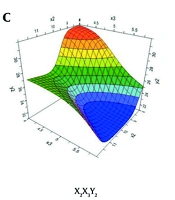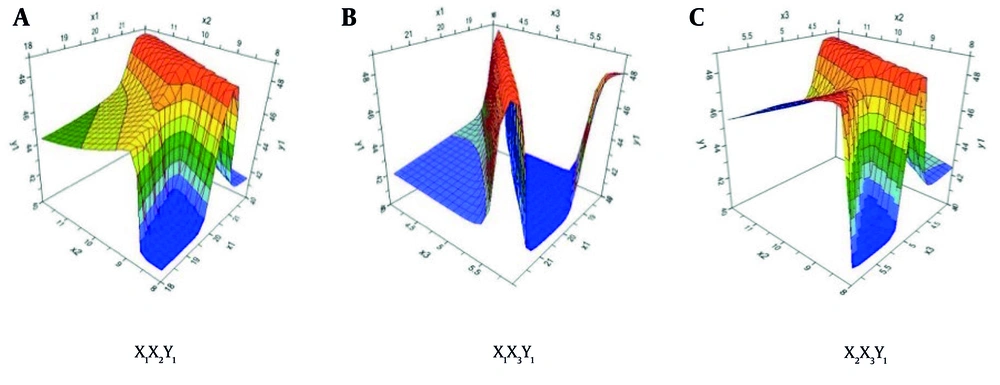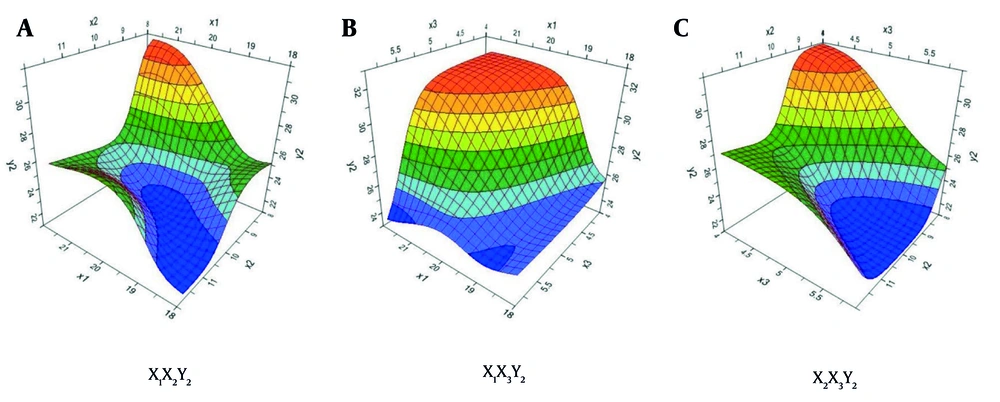1. Background
Protecting the skin from ultraviolet (UV) rays is crucial to prevent premature aging, dark spots, and skin cancer (1). Sunlight emits UVA and UVB rays, which can damage the skin. Therefore, sunscreen is the most recommended solution according to the World Health Organization (WHO) (2). The mechanism of action of sunscreen involves absorbing, reflecting, or dispersing the rays of the sun (3-5). Herbal-based sunscreens offer a safer alternative by reducing the reliance on chemical agents in their formulations. Commonly used herbal ingredients include Polypodium leucotomos, Camellia sinensis, Lycopersicum esculentum, Daucus carota, and Curcuma longa (6-10).
Polypodium leucotomos (Polypodiaceae) contains bioactive compounds like polyphenols, ferulic acid, and chlorogenic acid. These compounds help protect the skin from UVA and UVB damage, offer antioxidant benefits, combat aging, and reduce sun-induced damage (11). Plant oils, including sesame, almond, coconut, and olive, serve as natural sunscreens. Almond oil, rich in vitamin E and fatty acids like oleic and linoleic acids, provides UV protection, moisturizes, and offers antioxidant benefits (10, 12, 13). Camellia sinensis (catechins) and L. esculentum (lycopene) both have sun-protective properties (7).
This study presents, for the first time, a detailed formulation of a natural herbal sunscreen that combines P. leucotomos, almond oil, C. sinensis, and L. esculentum. This formulation fulfills the demand for safer, eco-friendly alternatives to traditional chemical sunscreens.
2. Objectives
The present study aimed to investigate cause-effect relationships, optimize the formulation, and assess the quality of herbal sunscreen.
3. Methods
3.1. Materials
Polypodium leucotomos leaves (moisture content, 12%) and C. sinensis leaves (moisture content, 12%) were supplied by Dai Nam Herbs (Vietnam) and met the specifications of the Vietnamese Pharmacopoeia V. Tomato fruit (moisture content, 20%) was purchased from Coop Mart supermarket (Vietnam). Almond oil, stearic acid, cetyl alcohol, beeswax, lanolin, glycerin, titanium dioxide, zinc oxide, cosmagel, nipagin, and propylparaben were purchased from Thanh Dat Chemical Company (Vietnam).
3.2. Process of Extraction
- Polypodium leucotomos leaves extract: One hundred g of P. leucotomos leaves (size, 1.0 - 1.6 mm) was placed into a 2000 mL Erlenmeyer flask. The heat-reflux method was used for extraction at 60 ± 2°C for 1 hour, repeated twice. Distilled water was used as the solvent, with a herb-to-solvent ratio of 1:10. All extracts were then combined and concentrated to a liquid extract (1:4) (14).
- Camellia sinensis leaves extract: One hundred g of C. sinensis leaves (size, 1.0 - 1.6 mm) was placed into a 2000 mL Erlenmeyer flask. The heat-reflux method was used for extraction at 60 ± 2°C for 1 hour, repeated twice. Distilled water was used as the solvent, with a herb-to-solvent ratio of 1:12. All extracts were then combined and concentrated to a liquid extract (1:4) (15, 16).
- Lycopersicum esculentum fruit juice: Five hundred g of L. esculentum fruit was crushed with distilled water (1:6 ratio). The mixture was ground finely and filtered to obtain fruit juice (17, 18).
3.3. Formulation of Herbal Sunscreen Product
The ingredients for the herbal sunscreen formulation are shown in Table 1. To prepare the water phase, glycerin, P. leucotomos leaves extract, C. sinensis leaves extract, and L. esculentum fruit juice were mixed and heated to 75°C. The temperature was maintained while sodium benzoate was added and stirred until fully dissolved (1).
| Ingredients | Rate (% w/w) |
|---|---|
| Polypodium leucotomos leaves extract | X1 |
| Camellia sinensis leaves extract | 10 |
| Lycopersicum esculentum fruit juice | 10 |
| Almond oil | X2 |
| Stearic acid and cetyl alcohol mixture (1:1) | X3 |
| Beeswax | 1 |
| Lanolin | 1.5 |
| Glycerin | 10 |
| Titan dioxide | 2 |
| Zinc oxide | 3 |
| Cosmagel | 2 |
| Nipagin | 0.2 |
| Propylparaben | 0.1 |
| Distilled water | Quantity sufficient to 100% (w/w) |
Formula for Herbal Sunscreen
To prepare the oil phase, a blend of stearic acid, lanolin, and cetyl alcohol was heated until melted. Almond oil was then added to the mixture and stirred until uniform, maintaining the temperature at 70°C (2). Gradually combining (2) with (1) while stirring at 950 rpm for 5 minutes formed a stable oil-in-water emulsion. Cosmagel, titanium dioxide, and zinc oxide were added to the emulsion and mixed until homogeneous (19). The independent and dependent variable parameters are shown in Table 2.
| Independent Variables | Level 1 | Level 2 | Level 3 |
|---|---|---|---|
| X1: Polypodium leucotomos leaves extract (%) | 18 | 20 | 22 |
| X2: Almond oil (%) | 8 | 10 | 12 |
| X3: Stearic acid and cetyl alcohol mixture (1:1) (%) | 4 | 5 | 6 |
| Dependent variables | Constraints | ||
| Y1: SPF value | Maximum | ||
| Y2: Spreadability (cm2) | Maximum | ||
The Independent and Dependent Variables in Experimental Design
3.3.1. Effects of Variables on Sun Protection Factor Value (Y1)
A 1.3 mg/cm2 cream was applied to a new untreated roughened polymethyl methacrylate (PMMA) plate (roughened side facing upward), and transmittance spectroscopy in the range of 290 - 400 nm was conducted using a Jasco V730 spectrophotometer. The blank control was the PMMA plate with no cream applied (20). The sun protection factor (SPF) value was calculated using the following Equation 1:
Where E(λ), the spectrum of erythema action; I(λ), the UV source's spectral irradiance; d(λ), the wavelength step (nm); Ao(λ), the average monochromatic absorbance of the test product layer before UV exposure.
3.3.2. Effects of Variables on Spreadability (Y2)
Cream (0.5 g) was placed between two glass plates, with a 100 g weight placed on the upper plate for 1 minute. The resulting spread diameter of the cream was recorded (21). The spreadability was calculated using the following Equation 2:
Where S, the spreadability (cm2); d, the diameter of the cream spread (cm).
3.4. Optimizing Herbal Sunscreen Formulation
Nineteen experiments (F1-F19) were designed using Design Expert software (version 6.0.6, Stat-Ease Inc., Minneapolis, MN, USA). BCPharSoft software was employed to analyze the data, investigate cause-effect relationships, and optimize the formulation. The optimized formula underwent triplicate validation, and predicted data from BCPharSoft software were compared with observed outcomes using SPSS version 26.0 (SPSS, Inc., Chicago, IL, USA).
3.5. Evaluation of Quality Standards for Herbal Sunscreen
Herbal sunscreen quality standards were based on the Vietnamese Pharmacopoeia V, SANS 24443:2013, and ISO 24443:2020, addressing appearance, physical stability, homogeneity, pH, spreadability, and SPF value.
- Appearance: The cream was uniformly colored in ivory-yellow, with a smooth texture and a faint herbal aroma.
- Physical stability: Ten g of cream was stored in a closed test tube at 45 ± 1°C for 48 hours, showing no changes in appearance or separation (22).
- Homogeneity: Four packaging units (0.02 - 0.03 g each) were spread evenly on four glass slides, covered with a second glass slide, and pressed to form a 2 cm spot. The spots were observed from 30 cm, and no visible particles were seen in three out of four specimens. If visible particles were present in most spots, the test was repeated with eight units, allowing no more than two visible particles (23).
- pH: One g of cream was diluted to 10% with distilled water, and pH and electrical conductivity were measured at 25°C using a pH meter. The average of three measurements was determined (23).
- SPF value and spreadability: As described previously.
4. Results
Design Expert software was used to design herbal sunscreen formulations, and the results are shown in Table 3.
| Run | Independent Variables | Dependent Variables | |||
|---|---|---|---|---|---|
| X1 (%) | X2 (%) | X3 (%) | Y1 | Y2 (cm2) | |
| F1 | 18 | 10 | 6 | 45.51 | 23.16 |
| F2 | 18 | 8 | 6 | 47.97 | 25.25 |
| F3 | 20 | 10 | 4 | 43.20 | 27.34 |
| F4 | 22 | 12 | 6 | 46.30 | 25.52 |
| F5 | 20 | 10 | 5 | 47.09 | 22.30 |
| F6 | 22 | 8 | 4 | 41.81 | 32.17 |
| F7 | 20 | 8 | 5 | 48.76 | 29.22 |
| F8 | 20 | 12 | 6 | 45.41 | 23.5 |
| F9 | 20 | 12 | 4 | 46.81 | 27.62 |
| F10 | 20 | 8 | 6 | 43.37 | 25.25 |
| F11 | 22 | 10 | 5 | 43.04 | 25.52 |
| F12 | 18 | 8 | 4 | 47.63 | 25.79 |
| F13 | 18 | 12 | 5 | 45.18 | 21.24 |
| F14 | 18 | 12 | 4 | 44.29 | 25.79 |
| F15 | 18 | 10 | 4 | 46.40 | 26.69 |
| F16 | 18 | 8 | 5 | 40.37 | 25.25 |
| F17 | 22 | 10 | 6 | 47.91 | 21.81 |
| F18 | 22 | 8 | 6 | 44.71 | 23.76 |
| F19 | 22 | 12 | 5 | 49.11 | 26.06 |
Results of 19 Experiments for Dependent Variables a
4.1. Investigating Cause-Effect Relationships
The data were input into BCPharSoft to analyze cause-effect relationships and optimize the formulation. The model accuracy statistics from the BCPharSoft outputs are presented in Table 4. This table shows that both R2 training and R2 test values were above 0.96, indicating high reliability of the model. These models proved to be appropriate for multivariate optimization. Three-dimensional (3D) response surface plots of the fitted models were presented to better illustrate the cause-effect relationships between the independent and dependent variables. Each 3D plot showed the effects of two independent variables while keeping the third variable constant.
| Dependent Variables | Y1 | Y2 |
|---|---|---|
| R2 test | 0.96 | 0.96 |
| R2 training | 0.98 | 1.00 |
Regression-Based Optimization
4.1.1. Effects of Variables on SPF Value (Y1)
To achieve the highest SPF value (Y1) as shown in Table 2, the 3D diagram (Figure 1) indicated that a high concentration of P. leucotomos leaves extract (X1) at 22% (level 3) increased SPF. Almond oil (X2) had minimal impact, and a low percentage (4%, level 1) of the stearic acid and cetyl alcohol mixture (X3) also contributed to higher SPF.
Response surface plots illustrating the impact of A, Polypodium leucotomos leaves extract (X1) and almond oil (X2); B, P. leucotomos leaves extract (X1) and stearic acid and cetyl alcohol mixture (1:1) (X3); C, almond oil (X2) and stearic acid and cetyl alcohol mixture (1:1) (X3) on SPF value (Y1)
4.1.2. Effects of Variables on Spreadability (Y2)
To maximize spreadability (Y2) as shown in Table 2, the 3D diagram (Figure 2) showed that P. leucotomos leaves extract (X1) at 20% (level 2) or 22% (level 3) was beneficial. Almond oil (X2) should be low (8%, level 1), while the stearic acid and cetyl alcohol mixture (X3) at 4% (level 1) or 5% (level 2) enhanced spreadability.
Response surface plots illustrating the impact of A, Polypodium leucotomos leaves extract (X1) and almond oil (X2); B, P. leucotomos leaves extract (X1) and stearic acid and cetyl alcohol mixture (1:1) (X3); C, almond oil (X2) and stearic acid and cetyl alcohol mixture (1:1) (X3) on spreadability (Y2)
4.2. Optimizing Herbal Sunscreen Formulation
The herbal sunscreen formula was optimized using BCPharSoft software, setting variables X1, X2, and X3 at 20%, 8%, and 5%, respectively. Three replicated batches were produced for validation, as shown in Table 5. SPSS version 26.0 was used to compare experimental and predicted results. No significant difference (P > 0.05) was found between predicted and experimental results in the one-sample t-test, confirming that the optimal formulation matched BCPharSoft predictions. Therefore, the optimized formulation of herbal sunscreen included 20% P. leucotomos leaves extract, 8% almond oil, and a 5% stearic acid and cetyl alcohol mixture (1:1).
| Responses | Y1 | Y2 (cm2) |
|---|---|---|
| Predicted | 48.80 | 29.30 |
| Observed (mean ± SD) | 47.32 ± 0.66 | 28.17 ± 1.00 |
| P-values | 0.061 | 0.191 |
Comparison Between the Predicted and Observed Results (n = 3)
4.3. Evaluation of Quality Standards for Herbal Sunscreen
- Appearance: The cream had an ivory-yellow color, a smooth and homogeneous texture, and a light, pleasant herbal scent.
- Physical stability: The cream maintained its original appearance and showed no signs of separation.
- Homogeneity: The cream achieved homogeneity.
- pH: The pH of the sunscreen averaged 6.06 ± 0.04, which is suitable for the skin's pH balance.
- Spreadability: The average spreadability of the cream was 28.17 ± 1.00 cm2.
- SPF Value: The sunscreen's average SPF value was 47.32 ± 0.66.
5. Discussion
This research combined P. leucotomos leaves extract, almond oil, C. sinensis leaves extract, and L. esculentum fruit juice to create a sunscreen with enhanced SPF protection. This approach reduced the use of chemical sunscreen ingredients that may have side effects. It utilized each component's unique protective and antioxidant properties, enhancing therapeutic outcomes while nourishing and renewing the skin (8).
Almond oil, rich in oleic and linoleic acids, provides moisture and improves skin protection. It forms a natural barrier on the skin, allowing easy absorption without leaving a sticky or heavy residue. A study by Montenegro and Santagati (24) found that almond oil has a natural SPF of about 5, enhancing the overall SPF of the product.
Emulsifiers were crucial for maintaining emulsion stability, influencing texture, and ensuring safe application on sensitive skin (7, 25, 26). In this sunscreen formulation, stearic acid and cetyl alcohol not only stabilized the emulsion but also enhanced the user experience. Stearic acid, a widely used natural fatty acid, improved the product's structure, thickness, and skin adherence. Cetyl alcohol assisted in emulsification, softened the skin, and reduced greasiness (27, 28).
Pratiwi et al. reported an SPF of 4.90 for a sunscreen with lycopene from tomatoes (18). Bhattacharya and Sherje found an SPF of 13.09 for a sunscreen from C. sinensis (29). Stusy by Panditharathna and Rajapakse showed that a sunscreen made with almond oil had an SPF of 14.52 (30), and Aguilera et al.'s study on a sunscreen derived from P. leucotomos leaves extract revealed an SPF of 42.22 (31). In this study, the formulation combining P. leucotomos, C. sinensis, L. esculentum, and almond oil achieved an SPF of 47.32 ± 0.66, highlighting the enhanced SPF from these herbal components.
The study highlighted that combining plant extracts enhances the effectiveness of natural sunscreens, addressing the low SPF of single-ingredient products. Its focus on safety and environmental sustainability makes it ideal for sensitive skin or for those avoiding chemical agents (32, 33). Spreadability was crucial for sunscreen efficacy and user experience, ensuring easy, uniform application, preventing clumping, and improving protection. Products with excellent spreadability offered a light, non-sticky feel, encouraging regular use (34).
5.1. Conclusions
Overall, this research contributed to advancements in natural cosmetics, meeting the growing demand for eco-friendly products and supporting the expansion of Vietnam's sunscreen market. However, further in vivo studies are necessary to fully validate its safety and long-term efficacy.


